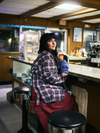Lucrecia Dalt Wants to Stay Like This Forever
A conversation with the Colombian musician on geology, near-death experiences, and her new album, ‘A Danger to Ourselves.’

The day Lucrecia Dalt held an advance listening session at Brooklyn’s Public Records felt netherworldly: a freak downpour had drenched the streets and caused a flood warning, turning the air thick and the twilight sky an eerie grey-green. It was an ominous mood to listen to A Danger to Ourselves, the experimental musician’s inventive seventh album, on which percussion sounds melodic, sound sounds sculpted, and her voice growls and coos about big topics like love and freedom and release. Dalt wore an oversized grey suit and yellow-tinted shades over her optical glasses, and was in a joyous mood, hugging fans and comrades—including percussionist Alex Lázaro and bassist Cyrus Campbell, who played on the album—despite everyone being simultaneously soaked with rain and sweating from the torpid air.
A few weeks earlier, Dalt’s heart had stopped for eight seconds during an epileptic seizure. That same day, she released the single “Caes,” which had been inspired by the concept of freefall. Since then, she told me, she’d been experiencing life as if in technicolor; being so close to death had amplified the state of living. Candlelight flickered in the faces of the rapt crowd as we listened to A Danger to Ourselves on the hi-fi sound system, which brought into focus how meticulously captured each vocal flick and marimba hit was, in part thanks to her sound mixer and partner, the British musician David Sylvian. Afterwards, in front of the audience, we spoke about the making of the album, how her environment influences her music, and how her near-death experience has affected her consciousness. An edited portion of our conversation follows.





